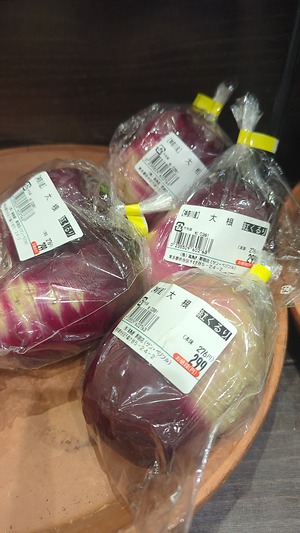


Red Beni Kururi Daikon
Estimated Inventory, lb : 0
Description/Taste
Red Beni Kururi Daikons are a mid-sized daikon, or Japanese radish, that weighs about 800 to 1200 grams, denser than the average radish. They have a stubby, egg-shaped appearance with rough fushia-colored skin. The outside of the radish features faint horizontal lines wrapping around it, with occasional white striations, especially near the bottom. Thick, purple-red stems and dainty green leaves reminiscent of curled lettuce grow out the top of this variety. A small nub forms a bump on the bottom of the root. The flesh of Red Beni Kururi Daikons is the same fuschia hue as their skin. When sliced widthwise, the color darkens towards the center. The outer ring of the radish features lighter pink lines that radiate towards the deep fuchsia core, resembling sun rays. The flesh is dense and offers a balance of firmness and softness, making it easier to consume raw compared to other daikon varieties. Red Beni Kururi Daikons have a crisp, crunchy, juicy bite with a hint of sweetness.
Seasons/Availability
Red Beni Kururi Daikon is available year-round, with peak harvesting seasons in spring and fall.
Current Facts
The botanical name for Red Beni Kururi Daikons is Raphanus sativus var. longipinnatus and they are from the Brassicaceae family. Their official name is Beni Kururi 521 Daikon. Daikon, which means big root in Japanese, are often referred to as winter radishes and are native to East Asia. In Cantonese, they are called lo back, in Mandarin luo bo, and in South Asian countries, they are known as mooli. While most daikon varieties are white, they can come in many colors including green, red, and purple. They may also have cylindrical, oblong, or spherical shapes. Other varieties of daikon include the Miyashige White, KN-Bravo, Japanese Minowase, Alpine, and Shunkyo. Red Beni Kururi Daikons are often used to add color, crunch, and subtle sweetness to Asian dishes.
Nutritional Value
Red Beni Kururi Daikons contain vitamin C, a nutrient essential for immune and skin health, wound healing, and protection against free radical damage. They are a source of anthocyanins, compounds that give the radishes their vibrant color, help suppress fat absorption, and have anti-aging properties. This variety contains calcium and magnesium, which are necessary for bone and teeth health, muscle and nerve function, blood clotting, and proper blood pressure levels. Red Beni Kururi Daikons’ potassium content promotes heart health and maintains fluid balance. The vegetable contains copper and folate, which are essential for iron metabolism, brain function, and healthy development during pregnancy. Red Beni Kururi Daikons are a low carbohydrate food, making them a good food for preventing blood sugar spikes.
Applications
Red Beni Kururi Daikons can be eaten raw, steamed, grilled, pickled, or used as a garnish. When fresh, this variety may be thinly sliced and tossed into salads and slaws with cucumbers, cabbage, carrots, oranges, peanuts, sesame seeds, mint, cilantro, and leafy greens. When pickled, they make a complementary topping for fried chicken, buffalo wings, salmon, rice bowls, short ribs, and barbeque. Red Beni Kururi Daikons are easily incorporated into stir-fries, sauces, soups, soba noodles, and banh mi sandwiches. They may be used to make Mooli Parathas, an Indian flatbread made with radish. If you cook them with rice, they will turn the rice an intriguing pink hue. Red Beni Kururi Daikons blend well with soy sauce, mirin, nori, scallions, wasabi, chiles, garlic, garam masala, beef, kimchi, tofu, sprouts, and broccoli. To store, wrap them in plastic and refrigerate for up to two weeks.
Ethnic/Cultural Info
Daikon radishes were a popular food in Japan during the Edo Period, and by the end of this era, the Miura Peninsula in Kanagawa Prefecture emerged as the epicenter of radish production. Some of the most popular varieties throughout Japanese history included the Nerima, Kameido, Miura, Koenbo, Nakabukura, and Aokubi daikons. Modern-day Japan produces nearly 90 percent of all daikon varieties, of which there are over 100. Recent efforts have focused on preserving older daikon cultivars that declined in production due to natural disasters, disease, and harvesting challenges.
Geography/History
Radishes originated from the coasts of the Mediterranean and Black Sea and were introduced to Japan over 1,300 years ago, where they became known as daikon. They soon became one of the most representative Japanese vegetables, growing drastically in popularity throughout the 17th century. Travelers and merchants spread daikon throughout the country. As a cultivated variety that uses breeding methods without generic manipulation, Red Beni Kururi Daikons are not found in the wild and are instead produced commercially in Japan. Beni Kururi radish is a newer variety that is not often found in international supermarkets. They are mostly sold by specialty markets that focus on novelty vegetables.








